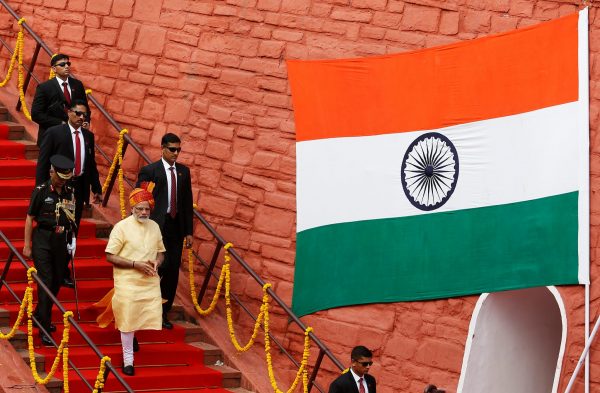Modi came to office enjoying the image of a strong and capable economic administrator. He was widely expected to push ahead with economic reforms and clean up the messy regulations that make India a difficult place for doing business. His signature ‘Make in India’ initiative, launched within a few months of assuming office and aimed at making India a global industrial powerhouse, resonated well with the early impression of what he might achieve. So did his calls to improve the ease of doing business across the country.
Modi’s government significantly liberalised foreign investment rules in ‘sensitive’ sectors that were previously either blocked to foreign investment, or only allowed it to a small degree under tight conditions. These enabling policies and Modi’s personal image have been major drivers of a surge in investor interest in India. India attracted around US$60 billion in foreign direct investment (FDI) in 2016–17, making it one of the world’s largest recipients of foreign investment.
The excitement about the lift in investor interest and high FDI inflows has nonetheless been accompanied by disappointment about the unfinished reform agenda.
Efforts to amend the land acquisition regulations, enacted by the Manmohan Singh administration, that increased the cost of acquiring land for infrastructure projects, did not succeed. Regulatory reforms to ease labour market inflexibility are also yet to be implemented. Both reforms are essential to improve the investment climate and ease of doing business in India.
The Indian economy today nurses serious weaknesses despite high rates of GDP growth. Foremost is the lack of jobs for the country’s large and growing youth population. Modi’s biggest economic challenge is to create enough jobs to ensure that the demographic dividend does not turn out instead to be a massive liability.
The socioeconomic ramifications of fewer jobs are compounded by agrarian distress. The incidence of farmers committing suicide due to bankruptcy continues to increase, forcing large states like Uttar Pradesh, Maharashtra and Punjab to write off big chunks of agricultural lending. These debt waivers force national banks, already saddled with large volumes of non-performing loans, to further raise their perception of the risk of agricultural loans, exacerbating the squeeze on rural credit.
While farmers are forced into debt by crop failures precipitated by climate change-induced weather events, loan waivers are merely an ad-hoc political response to agrarian distress. The Modi government is yet to find a solution to the structural issue of sustaining farmer incomes and improving their ability to service loans.
Lack of job opportunities and a troubled agricultural sector could become serious political challenges for Modi, given that youth and farmers comprise a big slice of the electorate.
Two of the Modi government’s most far-reaching economic initiatives were the demonetisation of more than 80 per cent of currency in circulation in November 2016, and the introduction of the goods and services tax (GST) from July 2017.
The sudden lack of access to cash inflicted by demonetisation hit the informal sector of the economy, forcing a contraction in economic activity. Though not as disruptive as demonetisation, implementation of the GST has hardly been a total success. With its multiple tax rates, significant commodities like crude oil, petroleum products, alcohol and electricity are not caught under its ambit.
Both demonetisation and the GST reform are examples of the Modi government’s proclivity to inflict reform ‘shock’ on the economy and manage what are desirable policy changes ineptly. By ignoring the costs of implementing these measures on an economy where the bulk of livelihoods are delivered through the informal sector, the government’s drive to formalise the economy risks leaving important parts of the community behind.
Where Prime Minister Modi has delivered beyond expectations is in his conduct of foreign policy. Under Modi, India’s external engagement has a new-found sure-footedness. India appears to be shedding the constraints of its ‘non-aligned’ past and has begun embracing ‘multi-alignment’, with economic benefits now becoming a major focus of foreign policy. India has begun building partnerships with countries like Israel and Iran, struck nuclear fuel deals with Australia, Canada and Japan and reached out to the small island states in the Indian Ocean and South Pacific.
India’s enthusiasm to work with its neighbours has had mixed success. While relations have improved remarkably with Bangladesh and Sri Lanka, and partly with Nepal, ties with Pakistan are yet to mend. There have also been continuing spats with China, including the latest border stoush. But on other fronts, the Modi government has been more pragmatic in collaborating with China, particularly in forums like BRICS, the Shanghai Cooperation Organisation and the Asian Infrastructure and Investment Bank.
Modi’s robust and multi-aligned foreign policy has not been accompanied by a similarly energetic and proactive trade policy. India’s traditional stance as ‘difficult and defensive’ in trade negotiations bedevils a strategic economic reform agenda.
The policy establishment is allergic to imports, and the ‘Make in India’ initiative appears like mere repackaging of the old import-substitution strategy.
Looking ahead, the contrasting successes and failures of Modi’s prime ministership thus far underscore the changes his style of leadership has brought.
Modi is clear in areas where he has a ‘free’ hand, particularly in foreign policy and economic policies under his direct control. In other areas, such as the GST, compromise is on full display.
Amitendu Palit is Senior Research Fellow and Research Lead on trade and economic policy at the Institute of South Asian Studies, National University of Singapore.
An extended version of this article appeared in the most recent edition of East Asia Forum Quarterly, ‘Japan repositions’.

